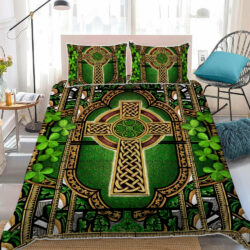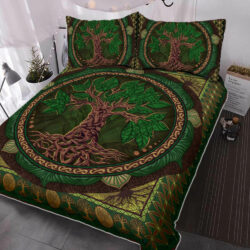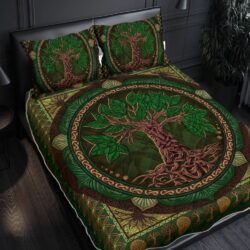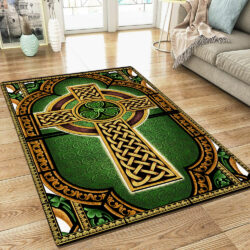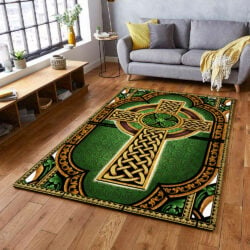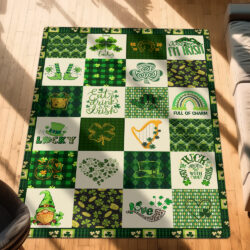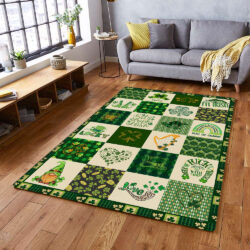Best-selling products
Best-selling products
Best-selling products
Irish rugs have a long and rich tradition in Ireland, dating back more than 100 years. Because of the Celtic art incorporated into these rugs, they quickly gained popularity in many parts of the world. As a result, it cannot prevent us from coming up with the idea of creating some rugs inspired by Irish culture. Now, let’s look at the history of Irish rugs and how they were made to see why they so influence our rugs.
The Origin of Irish Rugs (originally called Donegal Rugs)
In the late 1890s, successful businessman Alexander Morton sought new rug-making opportunities in Ireland. Then he found himself near a small coastal town named Killybegs in Donegal.
Killybegs provided Morton with many advantages. That gave him easy access to the harbor and its facilities while only an hour away from Dublin by boat.
In addition, while other towns considered this geographical isolation a disadvantage, Donegal natives cherished it. They are so fiercely protective over their homeland that they have preserved many traditional practices. They include making wool items such as jackets and carpets.
That accidentally gives them an edge against similar rug makers who didn’t have these local resources available to them.
Besides, Donegal County would offer Morton a constant supply of experienced laborers willing to work for him. With the county undergoing tough times, he was happy to see that many people seeking employment had previous experience in carpet making and appliqué. That would help them transition to weaving rugs quicker.
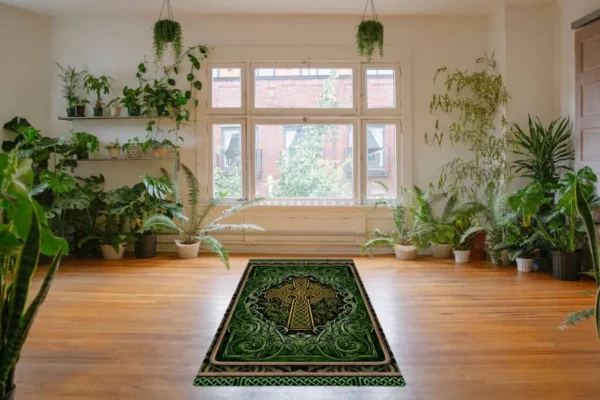
How Ireland Rugs Was Made
Rug Materials
Morton only used wool to make his rugs. These wool fibers were primarily derived from sheep raised on local farms. Morton chose local material because it is dependable, inexpensive, and simple to manage. It is also a significant source of income for farmers and woolen workers in Donegal.
Rug-making Techniques
Irish rugs are woven from the main techniques such as hand-knotting, hand-looming, flatweave, hand-tufting, and hand-hooking. These rug-making techniques have been used on the majority of traditional Persian rugs.
Besides, programming is a new technique that has emerged in recent years. It is similar to the previous techniques, but programmed rugs are made by a machine.
Celtic Rug Designs
An Irish area rug is usually diverse in design. Their colors reflect the vast beauty of nature and often mimic what you would see outdoors at a different time of year. You’ll also find these patterns primarily rely on the Celtic knot. But there are many others, including crosses, shamrocks, and maybe leprechauns.
How Celtic Rugs Have Become Popular In The World
The first big order for Irish rugs came from a local church in 1901. It led to another order from the government office in Cork just shortly after. That also opened the opportunity for the rug to be displayed at an exhibition. It was where Donegal Irish Rugs were introduced for mass consumption.
Soon, more prominent individuals such as King Edward, Queen Victoria, and other royals bought the lesser-known products. And that’s what helped put it on the map.
In addition, it wasn’t long before top interior designers across Europe spotted them. Those artists loved incorporating these exquisite designs into their own homes or business ventures because of their timeless art nouveau motifs and intricate craftsmanship.
Today, the Killybegs production site is still operational but more like a historical tourist attraction. It was made for visitors to explore what rug-making was like over 100 years ago.
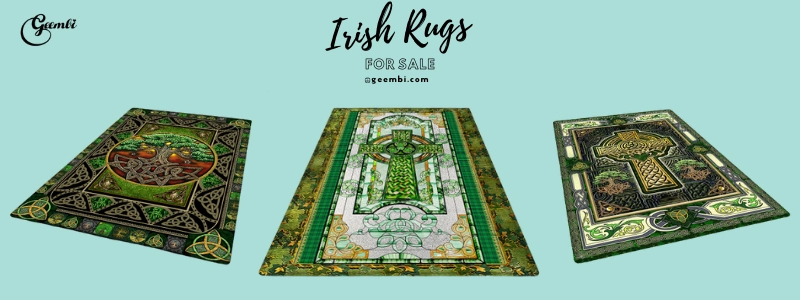
Geembi Irish Rugs Inspired By Celtic Culture
A Piece of Info About Our Rug Material
While we are not experts in wool, which is the foundation of most traditional Celtic area rugs, we are confident in our Polyester rugs.
Polyester is made from polyester fibers, as the name implies. They are synthetic fibers with a high ethylene content derived from petroleum. Polyester is, in essence, a type of plastic.
As a result, Polyester products have good durability, are anti-wrinkle, anti-mildew, easily laundered, and inexpensive when compared to other materials.
In short, every Geembi product is designed to be long-lasting and simple to use, so that customers can enjoy their purchases for as long as possible. We also use advanced color printing technology, which brings every detail and color to life on the rugs.
What Truly Inspires Us is the Irish Culture
The history of Irish rugs and Ireland’s fascinating cultural symbols have truly inspired us to make our rugs.
Browsing through our rug selection, you should see many different designs. Although they have a similar color, Green, each depicts other Irish symbols. That could be a Celtic knot, Crosses, Shamrock, or Leprechauns.
Those are the famous symbols for St. Patrick’s Day as well. So, whether you are looking for an Irish rug to celebrate March 17 or for year-round use, we’ve got you covered.
Why You Should Choose Our Rugs
Below are the reasons why our rugs are different and why you choose them:
- Durable, smooth, anti-mildew and anti-wrinkle
- Vivid colors
- Super easy to care for and store
- Unique designs (you cannot find them anywhere else) featuring the most famous Irish symbols and traditional figures
- Can be placed in most rooms in a house.
- Can be given as beautiful gifts for Irish families and friends
- Budget-saving
- Excellent customer service (we’ll reply to your email in just a blink)
The Bottom Line
For over a century, Irish rugs have been the focal point of every Irish home. Its distinctive designs and diverse weaving and dyeing techniques have brought it fame worldwide, particularly in Europe and America. Today, Celtic design rugs come in a wide range of styles to meet various needs. Regardless of whether they are artisans or industrial manufacturers, they have successfully preserved the core value of their Celtic rugs.
It is 100% the same at Geembi, but with more effort of making our rugs last for years. We hope the information above is helpful, and you’ll find it easy to choose a perfect carpet!
If you have any concerns about our rugs, please give us a shout at [email protected]. Thank you for reading!



